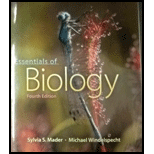
Concept explainers
To explain:
The way through which the information is relayed through the signal transduction pathway.
Introduction:
The signal transduction can be defined as the process through which the chemical signals which are released from the cells catalyze the cellular responses through a series of reactions. The recipient cells have special proteins which detect the stimuli; these proteins are known as the receptors.
Explanation of Solution
The chemical signals released by the sender cells alter the behavior of the recipient cells. The specialized function of a cell is determined by these chemical signals. The chemical signals also facilitate the coordination of the growth and normal functioning of the cell.
The signal transduction pathway is relayed in between the cells through the chemicals that bind to the receptors present on the plasma membrane of the recipient cells. On receiving the signals, the receptor protein conducts a cascade of reaction, which transducer the signal between the cells. The last reaction of the pathway leads to the formation of a product, which directly affects the functioning of the cells.
Mostly the last product is a transcription factor which either activates or deactivates the gene. The activation of the gene by the transcription activator leads to its transcription. The translation of  forms a protein stimulates the
forms a protein stimulates the
The signal transduction initiates when the chemical signals released by the sender cell are received by the receptor present on the plasma membrane of the target cell. The receptor protein initiates a cascade of reaction. The last reaction of signal transduction pathway forms a product which alters the expression of gene. The activation of gene leads to the formation of a product which carries out the response in the cell.
Want to see more full solutions like this?
Chapter 21 Solutions
Essentials of Biology
 Human Anatomy & Physiology (11th Edition)BiologyISBN:9780134580999Author:Elaine N. Marieb, Katja N. HoehnPublisher:PEARSON
Human Anatomy & Physiology (11th Edition)BiologyISBN:9780134580999Author:Elaine N. Marieb, Katja N. HoehnPublisher:PEARSON Biology 2eBiologyISBN:9781947172517Author:Matthew Douglas, Jung Choi, Mary Ann ClarkPublisher:OpenStax
Biology 2eBiologyISBN:9781947172517Author:Matthew Douglas, Jung Choi, Mary Ann ClarkPublisher:OpenStax Anatomy & PhysiologyBiologyISBN:9781259398629Author:McKinley, Michael P., O'loughlin, Valerie Dean, Bidle, Theresa StouterPublisher:Mcgraw Hill Education,
Anatomy & PhysiologyBiologyISBN:9781259398629Author:McKinley, Michael P., O'loughlin, Valerie Dean, Bidle, Theresa StouterPublisher:Mcgraw Hill Education, Molecular Biology of the Cell (Sixth Edition)BiologyISBN:9780815344322Author:Bruce Alberts, Alexander D. Johnson, Julian Lewis, David Morgan, Martin Raff, Keith Roberts, Peter WalterPublisher:W. W. Norton & Company
Molecular Biology of the Cell (Sixth Edition)BiologyISBN:9780815344322Author:Bruce Alberts, Alexander D. Johnson, Julian Lewis, David Morgan, Martin Raff, Keith Roberts, Peter WalterPublisher:W. W. Norton & Company Laboratory Manual For Human Anatomy & PhysiologyBiologyISBN:9781260159363Author:Martin, Terry R., Prentice-craver, CynthiaPublisher:McGraw-Hill Publishing Co.
Laboratory Manual For Human Anatomy & PhysiologyBiologyISBN:9781260159363Author:Martin, Terry R., Prentice-craver, CynthiaPublisher:McGraw-Hill Publishing Co. Inquiry Into Life (16th Edition)BiologyISBN:9781260231700Author:Sylvia S. Mader, Michael WindelspechtPublisher:McGraw Hill Education
Inquiry Into Life (16th Edition)BiologyISBN:9781260231700Author:Sylvia S. Mader, Michael WindelspechtPublisher:McGraw Hill Education





